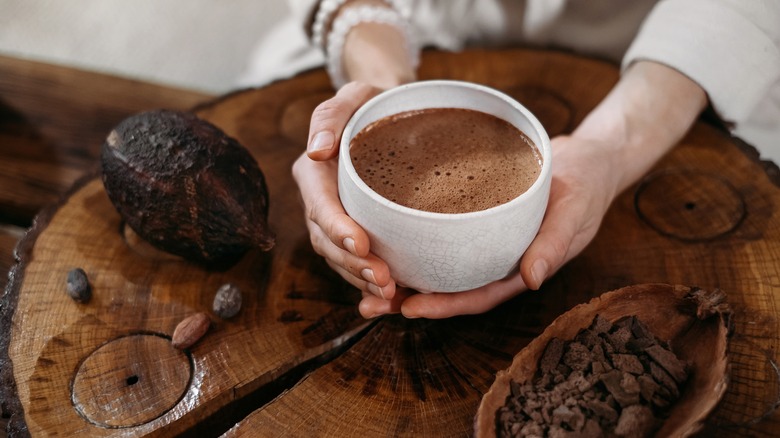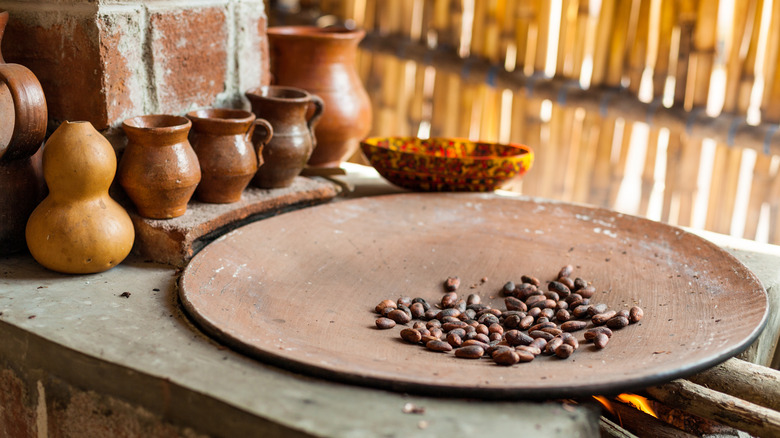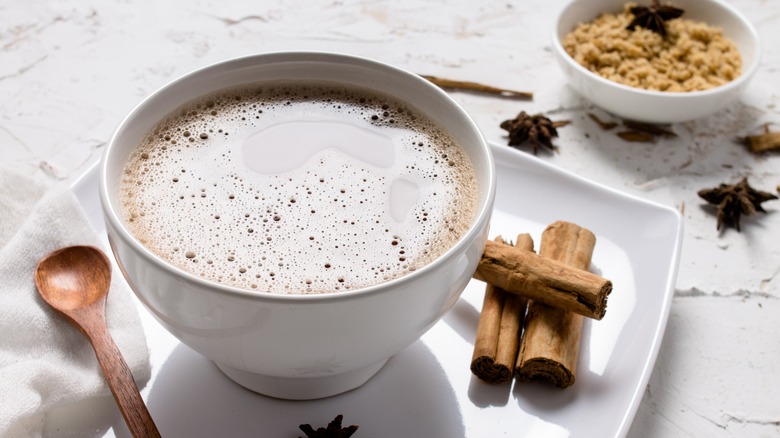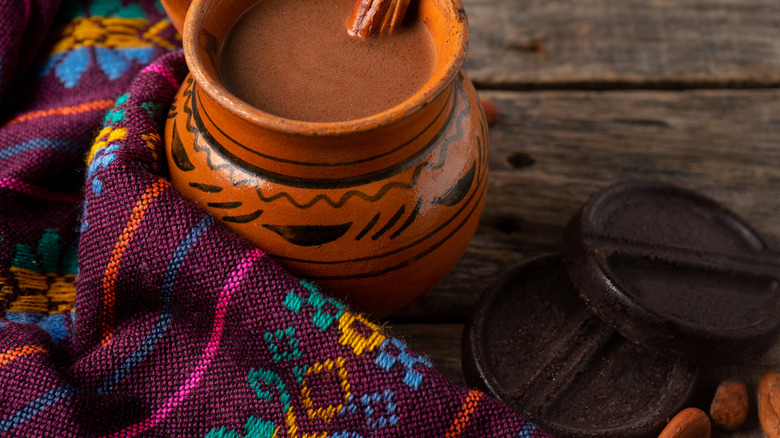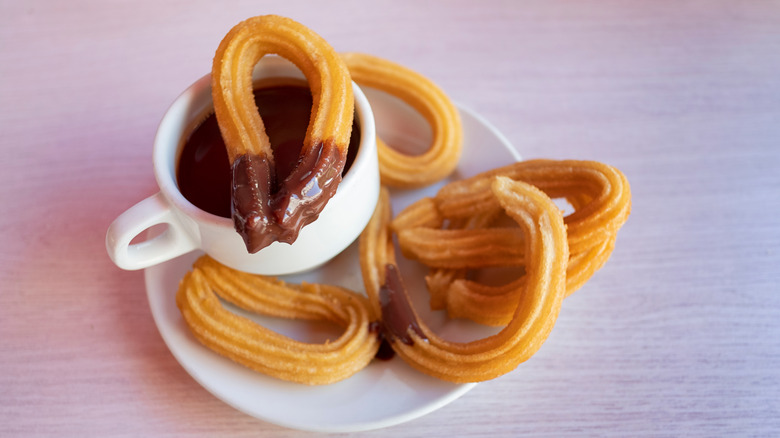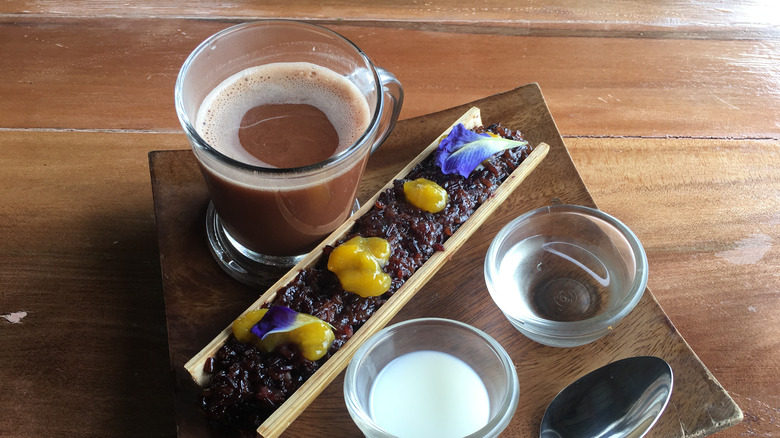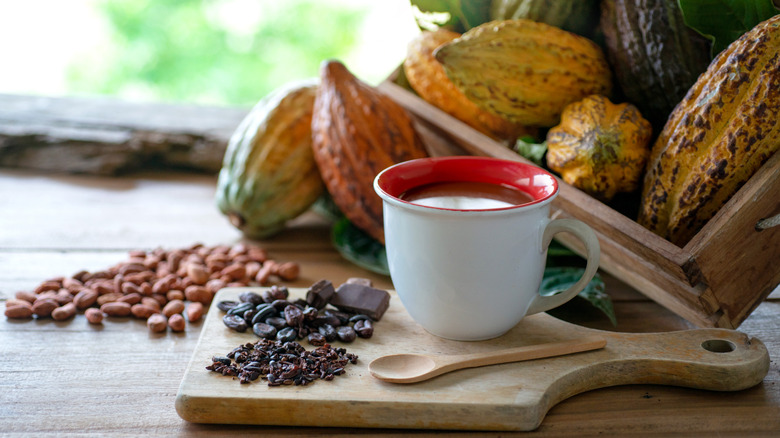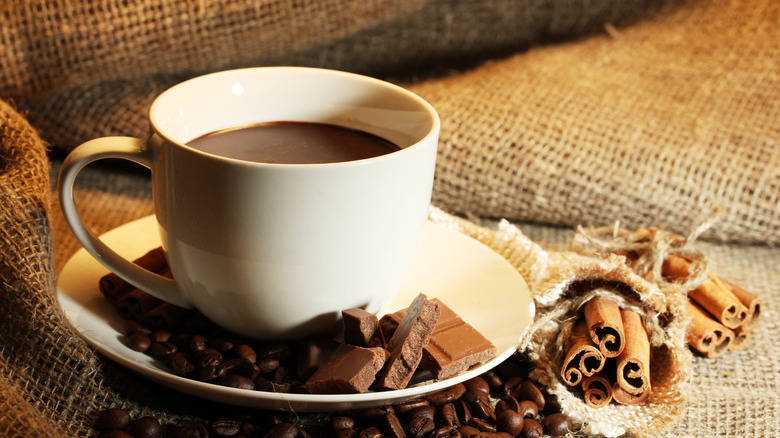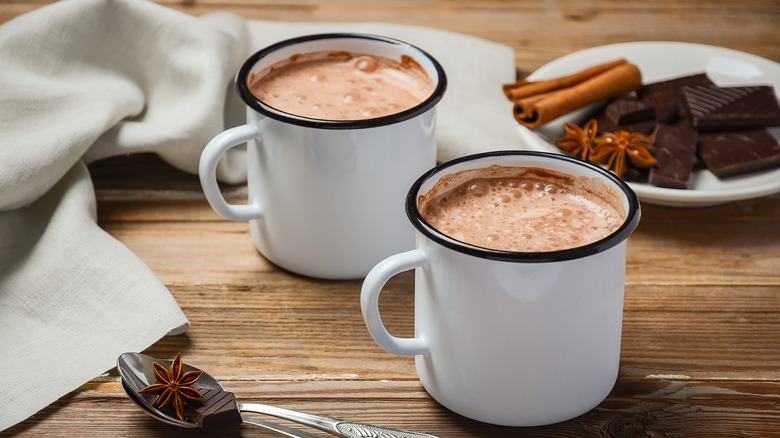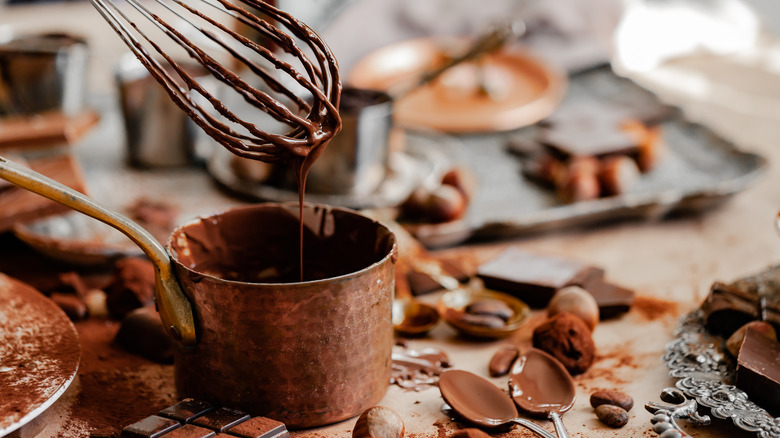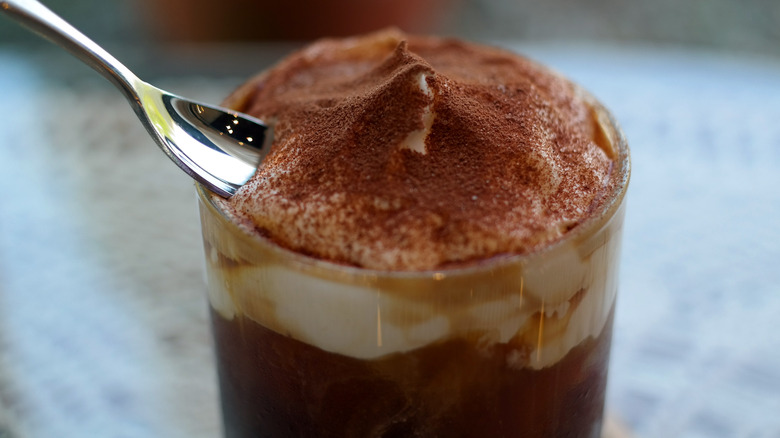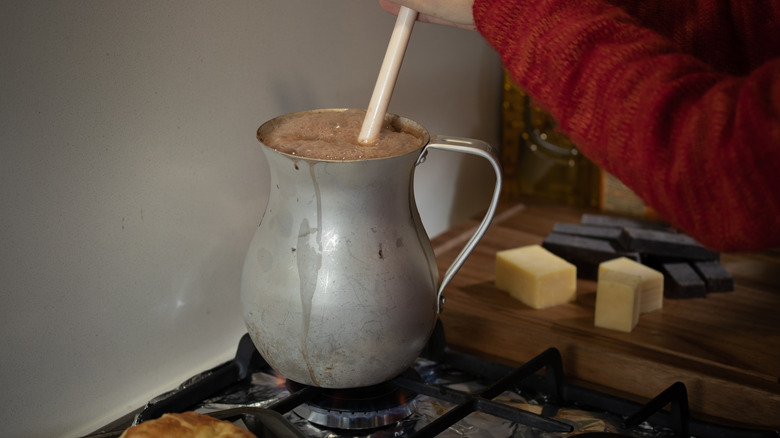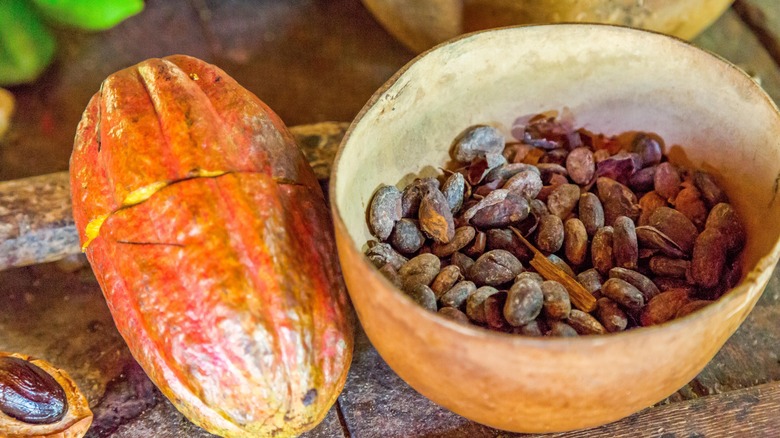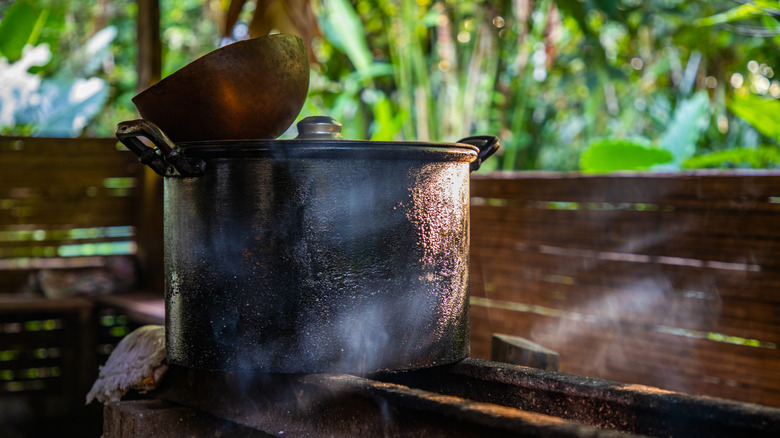14 Sweet Traditions Of Drinking Chocolate Around The World
Hot cocoa might conjure childhood memories of snow-soaked mittens, red noses, and melting marshmallows. Made with rich milk, cocoa powder, sugar, and vanilla, this sweet, silky cup of goodness hit the spot after a long day of chilly winter shenanigans. It may be surprising to some that for most of the world, drinking chocolate is not just a dessert, but a very grown-up drink enjoyed in the mornings and afternoons like coffee. In fact, the traditions of drinking chocolate from around the world vary greatly.
While you may think of drinking chocolate as an exclusively sweet beverage, many cultures enjoy the bitter smooth taste of roasted cocoa beans without added sugar. Some even add hot spices — or cheese! This brings the concept of loaded hot chocolate to a whole new level. Come with us around the world and explore the rich culture and history behind the cocoa bean and the enchanting traditions of hot chocolate.
The original drinking chocolate: Mayan
Because cocoa beans come in large pods and must be altered in order to get that rich flavor we love so much, it is quite a process to cultivate chocolate. Anthropologists believe that the Olmecs of Mexico were the first to begin using the cocoa bean, but the first written acknowledgment of drinking chocolate came from the Mayans, per History. Chocolate was a way of life for the Mayan civilization, who revered cocoa as sacred and holy. Although chocolate was used in celebrations and ceremonies, according to History, it was also a common household item. In fact, for some Mayans, cocoa was a component in almost every meal... talk about having a sweet tooth.
Honey, water, and spices like chili pepper were all mixed with cocoa to enhance the flavor and texture. Mayans enjoyed drinking frothy chocolate, much like we do in the U.S. Instead of sweetening the chocolate, they enjoyed the natural bitter, smoky, and rich flavors of the roasted bean enhanced by spices.
Xocolatl: Aztec
While the Mayans couldn't get enough of the roasted bean, the Aztecs treated it as a holy and sacred food given to them by the gods, and to only be used in celebration or by the upper class, per History. In fact, cocoa was more valuable than gold, which explains that beans were used as a form of currency, traded in the markets, and made into warm beverages. Beans were also fermented, cured, then roasted much like they are today.
Because of the status associated with chocolate, decorated cups were made to signify that one was enjoying the Mayan chocolate drink, called xocolatl. Xocolatl was a drink of the nobles, and was similar to the Mayan version, as it was unsweetened, foamy, and bitter, as described by World History. On occasion, the site explains that the lower class might have enjoyed the bean mixed with maize gruel, and pure chocolate was even occasionally given to victims sacrificed in ceremonies.
Mexican hot chocolate: Mexico
Similarly, modern-day Mexican hot chocolate is quite popular and based on the original cocoa drink created by the Mayans and adapted by the Aztecs, per Muertolandia. Mexican drinking chocolate is mixed with milk, sugar, and cinnamon. The addition of cinnamon in drinking chocolate was incorporated by the Spanish, as they had trouble sourcing vanilla at the time and used it as a replacement. When it was reintroduced with the spicy twist, it was instantly popular, and to this day cinnamon is a key ingredient in the hot drink. On occasion, chili powder is added to the mix for an exceptionally spicy and warming kick.
This mixture of flavors goes beyond the warm beverage we've come to love. Frozen Mexican hot chocolate is growing in popularity, and can be spiked with a boozy twist to give it a grown-up glow-up. Baked goods like Mexican hot chocolate cupcakes have that traditional flavor in finger-food form. However you consume it, we can all agree that it is a superior way to enjoy our favorite bean.
Chocolate caliente: Spain
When Hernán Cortés savagely conquered Mexico in the early 1500s, he learned of the valuable bean and tried chocolate for the first time, per the Culinary Collective. He was immediately intrigued and brought it back by the boatloads to Spain. It was there that monks made the first batches of the sweetened hot chocolate that we have grown to love in most corners of the world.
There is a difference between hot chocolate and hot cocoa. While we commonly use powder to make hot cocoa in the U.S., many countries in Europe, and all over the world, make hot chocolate using melted chocolate. This gives the drink a richer, fatter, fuller flavor and is typically considered to be more gourmet. In Spain, melted chocolate is the way to go. In fact, Spanish hot chocolate is often so thick that people dip churros and other pastries in it. It's enjoyed by children and adults alike, typically in the morning, but it can also act as an afternoon pick-me-up.
The Spanish are known for their love of chocolate, so it's no wonder that from the moment it entered the country, it would continue to be imported in great quantity.
Sikwate: Philippines
Sikwate is just one of the many incredible and unique Filipino foods you probably haven't tried yet. After Spain got the chocolate bug, they quickly realized that cocoa trees would not grow in their soil and climate, so they turned to one of their colonized Islands and began planting cocoa trees in the Philippines, per Eat Your World. The native cultures grew a liking to the taste, and developed sikwate, a drinking chocolate, flavored similarly to that consumed in the U.S. but made with an entirely different process.
After the beans are processed, dried, and roasted, they are hand-formed into tablets. These tablets are boiled and then frothed with a wooden whisk called a batidor, resembling a honey dipper. Milk and sugar are added to taste, and while most individuals prefer to soften the bitter flavors of the bean, some consume it without a sweetener.
The drink can only be described as velvety, says CNN, and is wildly popular throughout the Island, even after the Philippines were freed from the Spanish. In fact, many Filipinos have their very own cacao trees growing in their backyard, and process the beans by hand.
Koko Samoa: Samoa
Travel across the ocean to the South Pacific to enjoy a chocolaty beverage unique to the tiny Island of Samoa. Coca beans were thought to have been introduced to the island from Peru by sea travels around 700 A.D., per The Koko Samoa. Cocoa trees were planted around the island and thrived as they benefited from the nutrient-rich volcanic soil and biodegraded coconut husks.
Many Samoans have their own cocoa trees and use the beans to make a drink called koko Samoa. This drink is made from fermented, dried, and roasted seeds that are heated over an open fire, which can often be a social event. The roasted seeds are ground, made into a paste, and then whisked into hot water. Koko Samoa is commonly presented to guests, and although not quite as popular as kava, it's quite accessible on the island. The drink is often unsweetened, and enjoyed morning to night, typically by adults. Even though the climate is quite hot and humid, hot drinks are consumed to promote sweating to cool the body. Drinking "tea," referring to any hot drink, is quite popular for daily consumption.
West African hot chocolate: Ghana
If you're a fan of spiked hot chocolate recipes, then Ghana is a place you'll want to visit. West African hot chocolate is unique, flavorful, and boozy. In 1876, after a Teshie farmer snuck cocoa into Ghana from Guinea, the crop flourished, per Culture Trip. Today, it's one of the country's biggest exports, so it's no wonder that they have their own spin on the popular hot drink.
West African Hot Chocolate is typically made with dark chocolate, milk, vanilla, honey, and cinnamon. Rum is added to give it that extra grown-up kick. The mixture is rich, as the pure melted chocolate, milk, and vanilla give it that fatty, whole mouthfeel. The cinnamon and rum add a punch and pizzaz that goes unmatched. The flavors complement each other well. Luckily, cocoa is a big export product in the region, so it's accessible to try anywhere in the world. Look for the fair trade symbol, and brew a cup to cap off your night.
El submarino: Argentina
Argentina knows what it's doing when it comes to presentation. Instead of pre-mixing their drinking chocolate with milk, the consumer does it themselves! This could be arguably the original chocolate bomb, or chocolate brick if you will. El submarino is presented as a hot cup of milk, alongside a dark chocolate bar. The bar is dropped into the milk, and mixed with a spoon until the bar is fully dissolved. No wonder it's named after a submarine.
Whole milk is the main ingredient, and often vanilla and additional sugar are added to the mix. Special chocolate bars are produced for such an occasion and can be found locally, especially in the wintertime when the beverage is most commonly consumed. When making el submarino, it's important to get the milk pipping hot in a tall cup to retain the heat. The drinking chocolate is served with a tall spoon (similar to a sundae spoon) so that whoever is enjoying it can use it to stir the sweet melted bar into the milk. This interactive and decedent hot chocolate recipe is a favorite among children and popular with adults.
Cioccolata calda: Italy
There is a secret ingredient that makes cioccolata calda so rich, thick, and dense. While many other European countries use shaved chocolate, or pieces of chocolate bars in their hot chocolate mix, in Italy, they use cocoa powder along with cornstarch or flour. That's right, their drinking chocolate is so thick because they use an agent to thicken it, and it's worth the extra whisking, per La Cucina Italiana. Come winter, families and travelers from all over Italy wrap their hands around a wide-brimmed cappuccino mug and give themselves a big old hot chocolate milk mustache. The large opening in the mug allows for more enjoyment of the frothed top layer.
Drinking cioccolata is often described as drinking a warm shake or pudding, and can even be enjoyed by the spoonful, as described by Italy Magazine. In fact, sometimes espresso spoons accompany the beverage for such a purpose. Children and adults alike enjoy this rich delicacy, as it truly is the ultimate comfort food and drink combination.
Chocolat chaud: France
Nobody is surprised that France knows what it's doing when it comes to chocolate. It was originally consumed primarily by royalty, starting with King Louis XIII, per Chateau De Versailles. According to Chateau De Versailles, it was brought to him by his bride, Anne of Austria from Spain, in 1615. Louis XV and his mistresses grew fond of the drink as well and added egg as a thickener to the beverage. During his reign, chocolate grew so much in popularity that the first chocolate machines were invented and set up in France.
Today, chocolat chaud is made with chocolate, sugar, milk, or cream. It's quite thicker than typical drinking chocolate and contains more chocolate as well, as described by Nunu Chocolates. It's rich, deep, dark, and, delicious.
Chocolate is frequently enjoyed in the morning by the French, alongside bread and pastries, so it's no surprise that chocolat chaud makes its appearance early in the day alongside breakfast. Parisians know that it doesn't have to be cold out to enjoy this warm creamy beverage, so it's enjoyed year-round, and we think we can all get on board with that.
Viennese hot chocolate: Austria
Let's travel all the way to Austria, where decadence flourishes when it comes to drinking chocolate, and nothing is considered "too rich." Viennese hot chocolate is made with melted bittersweet dark chocolate, whole milk, sugar, vanilla, and heavy whipping cream as a topping. The secret ingredient is an egg yolk to thicken the mixture and add richness. Often, after the whipped cream is added to the top, Austrians will add a little shaved chocolate as a garnish, per Nunu Chocolates.
As perhaps the most exquisite version of drinking chocolate, Viennese hot chocolate is enjoyed all year round, although it has a louder presence in the colder months. During Christmas, rum is added to give it a boozy grown-up kick. Viennese iced coffee shares a similar decadence, and we are starting to this they are onto something in Austria. Be sure to leave room for this drink, because it's quite filling.
Chocolate santafereño: Colombia
Because the cocoa bean comes from their neck of the woods, Colombians know a thing or two about hot chocolate. Although they have been drinking chocolate since 400 B.C., per Wild Frontiers, the recipe has developed drastically over time to include a special ingredient that may surprise you.
After boiling water or milk until bubbles form, chunks of chocolate are added and whisked until frothy. The mixture is brought to a boil again and whisked. It's then served with (brace yourself) cheese! That's right, chocolate santafereño is served with chunks of cheese that are submerged in the hot beverage and enjoyed melted. This could perhaps be the best way to upgrade your hot chocolate that we've heard of so far.
This beverage is enjoyed in the mornings or afternoons and is a quite brilliant combination of salty and sweet. Think about it: Most cheese platters or post-dinner cheese boards include chocolate. Often, double crema or paipa cheese is used, but as an alternative, soft white Mexican cheese will do just fine.
Caribbean cocoa tea: St. Lucia
As it turns out, St. Lucia's cocoa tea isn't tea at all. In fact, it's closer to a thick hot cocoa, or warm shake, because of its ingredients and consistency. Traditionally, cocoa tea is made with a cocoa stick, made from fermented, dried, and then ground cocoa beans rolled into a stick shape, per Loop. This stick is then grated into a pot of boiling water, then additional spices are added to the mix like cinnamon, nutmeg, cardamom, fennel, and bay leaves. The mixture continues to boil, and a little milk and flour are added to thicken the mixture.
Traditionally, four dumplings were cooked in the pot, rounding out the beverage to be a complete meal. Today, this is still practiced but is less common. Caribbean cocoa tea has been popular since slavery was abolished on the island. Because of the accessibility of ingredients, health benefits, and that unforgettable rich flavor, the drink spread like wildfire and became and breakfast staple.
Kuna hot chocolate: Panama
Have you ever heard that chocolate is good for you? The Kuna Indians are piquing interest in the world's top health organizations for their low rates of cardiovascular disease, diabetes, and cancer as it correlates with their high consumption of cocoa, per Livewell. Now, the traditional Kuna hot chocolate recipe isn't your average dairy and sugar-laden mix. In fact, it has a few out-of-left-field ingredients that actually sound pretty scrumptious.
Livewell goes on to explain that the average Kuna Indian consumes around 40 cups of this chocolatey drink per week. This antioxidant-powered beverage has a very specific cooking process using a popular fruit: bananas. Bananas and boiling water are mixed into a pot, and ground cocoa beans are added. The mixture is heated and then strained. The mixture is described as creamy, and, although there is a small element of sweetness due to the bananas, the drink is overall bitter and rich.
While this may seem like a green light to load up on chocolate, keep in mind that Kuna chocolate does not contain dairy or sugar, so it's a far cry from your typical American chocolate bar or cup of cocoa.
